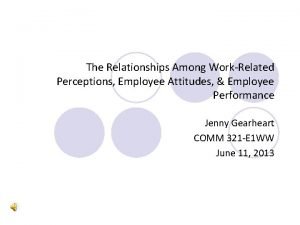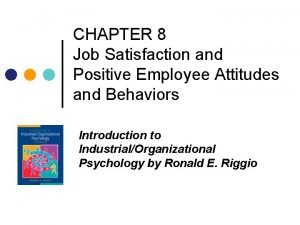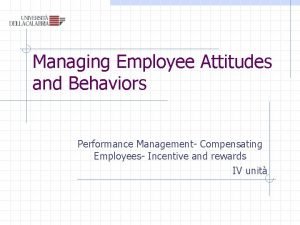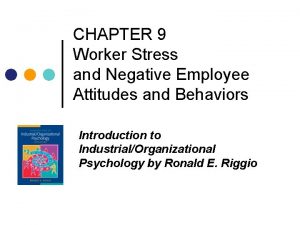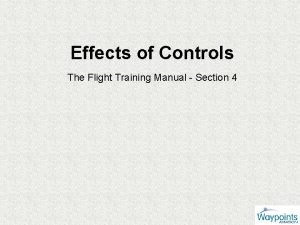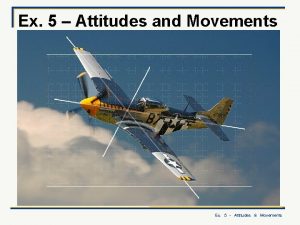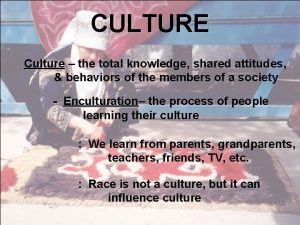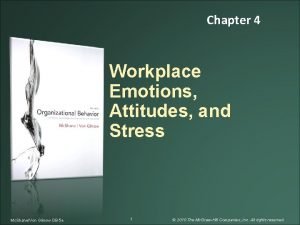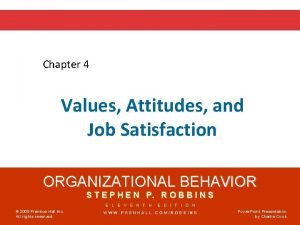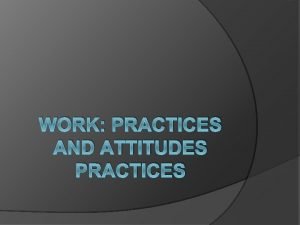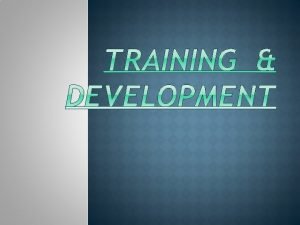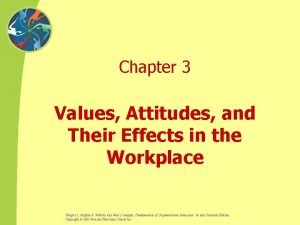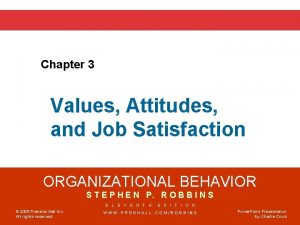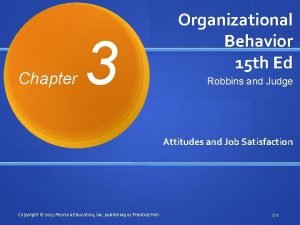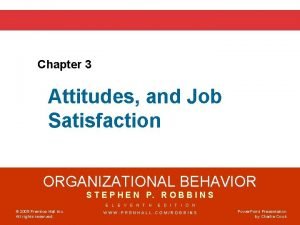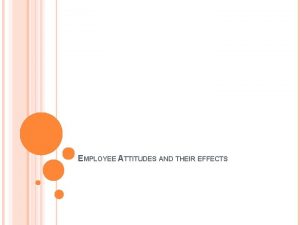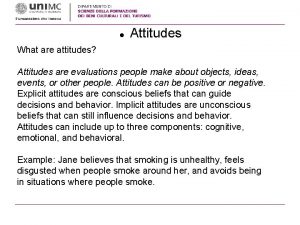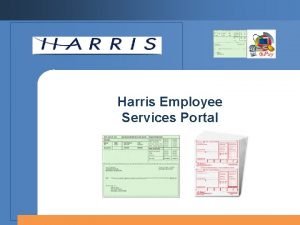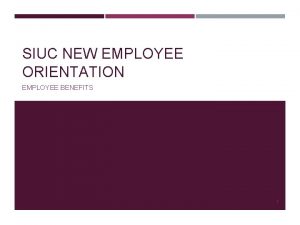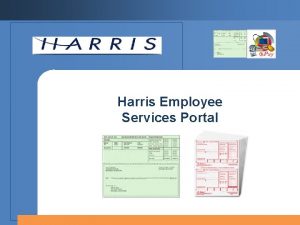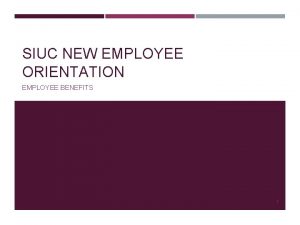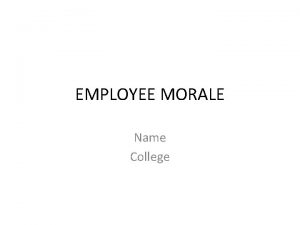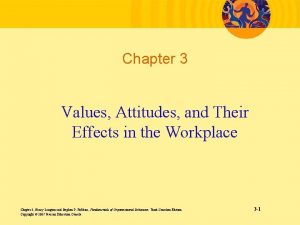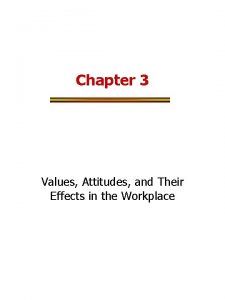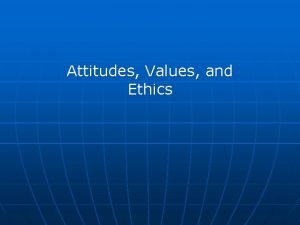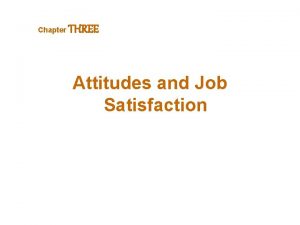LESSON 9 EMPLOYEE ATTITUDES AND THEIR EFFECTS Dr



























- Slides: 27

LESSON 9 EMPLOYEE ATTITUDES AND THEIR EFFECTS Dr. Mario A. Fetalver, Jr.

ATTITUDES - are the feelings and beliefs and largely determine how employees will perceive their environment, commit themselves to intended actions, and ultimately behave. Employee attitudes are clearly important to organizations. Negative attitudes *symptom of underlying problem * contributing cause of forthcoming difficulties *declining attitudes result in: *strike * work slowdowns * absences and *employee turnover) * a part of grievances * low performance * poor product ability * shabby customer service * employee theft

Favorable attitudes, on the other hand are desired by management because they tend to be connected with many of the positive outcomes that managers want. Employee satisfaction, along with high productivity

THE NATURE OF EMPLOYEE ATTITUDES *positive affectivity *optimistic *upbeat *cheerful *courteous *negative affectivity *pessimistic *downbeat *irritable *abrasive

Four Types of Attitudes that Managers Particularly Concerned Job Satisfaction *Job satisfaction is a set of favorable or unfavorable feelings and emotions with which employees view their work. *affective attitude – a feeling of relative like or dislike toward something. Elements of Job Satisfaction 1. Individual focus *job satisfaction typically refers to the attitudes of a single employee 2. Overall or Multidimensional *job satisfaction can be viewed as an overall attitude, or it can apply to the various parts of an individual’s job. *Importance aspects of job satisfaction include: *pay *one’s supervisor *the nature of tasks performed *an employees co-workers or team *the immediate working condition

3. Stability of job satisfaction *attitudes are generally acquired over a long period of time. *Job satisfaction is dynamic for it can decline even it develop. 4. Environmental Impact *job satisfaction is one part of life satisfaction. It influences general life satisfaction.

Some Related Elements of Life Satisfaction Family Job Leisure Life Politics Religion

Importance § Supervisors need to be alert to subtle clues about employee satisfaction levels. § Managers should also systematically study the job satisfaction of their employee and seek to improve it where appropriate. Level of Job Satisfaction § Only about 50 percent of those in the workforce that they are reasonably satisfied with their jobs. § The other 50 percents of millions workers are unhappy § Other 50 millions are probably dissatisfied with some specific aspect of their jobs.

Variety of factors that can influence a person’s level of job satisfaction: *level of pay and benefits *the perceive fairness of the promotion system within a company *the quality of working conditions *leadership and social relationships *the job itself (the variety oft asks involved interest and challenge the job generates, and the clarity of the job description/requirements).

*The happier people are within their job, the more satisfied they are said to be. *Job satisfaction is not the same as motivation, although it is clearly linked. *Job designs aims: *to enhance job satisfaction and performance *methods include job rotation *job enlargement *job enrichment *Other influences on satisfaction include: *the management style and culture *employee involvement *autonomous work groups

Job Involvement *is the degree to which employees immerse themselves in their jobs and invest time and energy in them, and view work as a central part of their overall lives.

Organizational Commitment *or employee loyalty, is the degree to which employee identifies with the organizational and one wants continue actively participating in it.

Work Moods *employees also have feelings about their job that are highly dynamic, they can change within a day, hour, or minute. This variable attitudes towards their jobs are called work moods.

Effects of Employee Attitudes *dissatisfied employees may engage in psychological withdrawal (e. g. daydreaming on the job. *physical withdrawal (e. g unauthorized absences, early departures, extended breaks, or works slow down. *or even overt acts of aggression and retaliation for presumed wrongs.

Employee Performance *Some managers cling to an old myth-that high satisfaction always leads to high employee performance-but his assumption is not correct. *A more accurate statement of casual relationship is that high performance contributes to high job satisfaction.

Figure 9. 3 The Performance-Satisfaction-Effort Loop Performance Rewards Economic Sociological Psychological Greater of lesser effort Perception of equity in rewards Satisfaction or dissatisfaction Fair Unfair Greater of lesser commitment Turnover Absenteeism Tardiness Theft Violence Poor organizational citizen

Turnover *as might be expected, higher job satisfaction is associated with lower employee turnover, which is the proportion of employees leaving an organization during a given time period (usually one year).

Relationship of Job Satisfaction to Turnover and Absences High Job Satisfaction Turnover absences Low Turnover and absences High

*Excessive employee turnover can have several negative efforts on an organization. They include: • Separation costs • Training cost for new employees • Vacancy costs • Replacement costs • Morale effects *Turnover may have functional effects.

Four Products of Employee. Organization Attitudes Employee’s attitude toward organization positive Employee Stays Employee is terminated a b c negative Employee leaves voluntary d Employee leaves by mutual agreement negative positive Organization’s attitude toward employee

Absences and Tardiness *Employees who have low job satisfaction tend to be absent more often. The connection is not always sharp, for a couple of reasons. First, some absences are caused by legitimate medical reasons; therefore a satisfied employee may have a valid absence. Second, dissatisfied employees do not necessarily plan to be absent, but they seem to find it easier to respond to the opportunities to do so.

Theft *Others forge checks or commit other types of fraud. All these acts represent theft, or the unauthorized removal of company resources. *Employee theft is part of a much broader ethical problem in organizations that involves bending the rules.

Violence *One of the most extreme consequences of employee dissatisfaction is exhibited through violence, or various forms of verbal or physical aggression at work.

STUDYING JOB SATISFACTION *In order to make sound decision in both preventing and solving employee problems. *A job satisfaction survey is a procedure by which employees report their feelings toward their jobs and work environment.

Other Effects *Low productivity, turnover, absenteeism, tardiness, theft and violence are all typically negative behaviors, for they harm the organization and sometimes its members. Many employees, however, hold positive attitudes toward their work organization, and these pay off in both obvious and more subtle ways. In particular, employees sometimes demonstrate organizational citizenship behaviors, which are discretionary actions above and beyond the call of duty that promote the organization’s success.

Benefits of Job Satisfaction *If job satisfaction studies are properly and administered, they will usually produce a number of important benefits, both general and specific. *Monitoring attitudes *is that they give management and indication of general levels of satisfaction in a company. *Additional Benefits *Training needs

Major Steps in a Systematic Approach to Conducting Surveys Identify reason for survey Obtain management commitment Develop survey instrument Administer survey Tabulate results Analyze results Provide feedback to participants Identify reason for survey
 Employee attitudes and employee performance
Employee attitudes and employee performance Positive employee attitudes and behaviors
Positive employee attitudes and behaviors Managing employee attitudes and behaviors
Managing employee attitudes and behaviors Negative employee attitudes
Negative employee attitudes Virtues and vices are attitudes. what are their objects?
Virtues and vices are attitudes. what are their objects? Language features and their effects
Language features and their effects Language features and their effects
Language features and their effects Hyperthyroidism
Hyperthyroidism Lesson 3 effects of the great depression
Lesson 3 effects of the great depression Ancillary controls aircraft
Ancillary controls aircraft Unit 14 social psychology
Unit 14 social psychology New zealand attitudes and values study
New zealand attitudes and values study Personal attitudes and dispositions also shape behavior
Personal attitudes and dispositions also shape behavior Characteristics of quality culture
Characteristics of quality culture Attitudes and movements
Attitudes and movements The total knowledge shared attitudes and behaviors
The total knowledge shared attitudes and behaviors Emotions and attitudes in a workplace
Emotions and attitudes in a workplace Values attitudes and job satisfaction
Values attitudes and job satisfaction Work practices and attitudes
Work practices and attitudes Training is the act of increasing the
Training is the act of increasing the Workplace emotions, attitudes, and stress
Workplace emotions, attitudes, and stress Values and attitudes in the workplace
Values and attitudes in the workplace Values attitudes and job satisfaction
Values attitudes and job satisfaction Aviation hazardous attitudes
Aviation hazardous attitudes Exchange of feelings and attitudes
Exchange of feelings and attitudes Compare and contrast the major job attitudes
Compare and contrast the major job attitudes Organizational behavior chapter 3
Organizational behavior chapter 3 Attitudes and persuasive communications
Attitudes and persuasive communications
